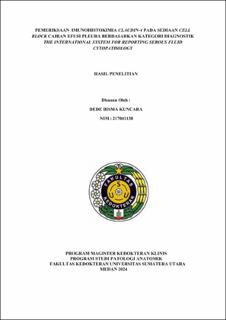| dc.contributor.advisor | Mariedina, Causa Trisna | |
| dc.contributor.advisor | Betty | |
| dc.contributor.author | Kuncara, Dede Bisma | |
| dc.date.accessioned | 2025-01-21T02:54:34Z | |
| dc.date.available | 2025-01-21T02:54:34Z | |
| dc.date.issued | 2024 | |
| dc.identifier.uri | https://repositori.usu.ac.id/handle/123456789/100377 | |
| dc.description.abstract | Background: Pleural effusion is a reflection of underlying pathological conditions such as
pulmonary, pleural, systemic disorders and even malignancy. Cytological examination of
pleural effusion aims to observe whether or not there is pleural involvement in metastases
from extrapulmonary malignancies. Immunohistochemical examination on pleural effusion
samples is needed to confirm the cytopathological diagnosis, as well as to improve
prognostic and predictive determinations using the cell block method on pleural effusion
fluid samples. Claudin-4 is a transmembrane protein that can provide consistent expression
in metastatic adenocarcinoma.
Objective: The aim of this study was to determine the immunohistochemical expression of
claudin-4 in pleural effusion fluid cell block preparations based on the diagnostic criteria
of The International System for Reporting Serous Fluid Cytopathology.
Method: This study consisted of 49 samples of pleural effusion fluid specimens processed
into cell block then analyzed with Hematoxylin and Eosin staining followed by claudin-4
immunohistochemical staining. This study is a descriptive analytical study with a crosssectional
approach to determine the cytopathological characteristics of pleural effusion
fluid based on the diagnostic category of The International System for reporting serous fluid
cytopathology with claudin-4 immunohistochemical examination conducted at the Prof. Dr.
Chairuddin Panusunan Lubis Teaching Hospital, University of North Sumatra.
Result: Among the 49 samples from pleural effusion patients, the largest age group was
found in 41-50 years consisting of 16 samples (32.65%). Based on gender, men consisted of
27 samples (55.10%) compared to women consisting of 22 samples (44.90%). The type of
transudate fluid consisted of 28 samples (57.14%) and exudate consisted of 21 samples
(42.86%). The largest volume of pleural effusion fluid was found with a volume of 11-20 mL
consisting of 15 samples (30.61%). The most cytological diagnostic characteristics were
found in the NFM category consisting of 42 samples (85.72%), MAL consisting of 7 samples
(14.28%). claudin-4 immunohistochemical expression was positive in the MAL category 7/7
samples (100%).
Conclusion: Immunohistochemical expression of claudin-4 was positive in all MAL
category samples and negative in all NFM category samples. | en_US |
| dc.language.iso | id | en_US |
| dc.publisher | Universitas Sumatera Utara | en_US |
| dc.subject | Pleural effusion | en_US |
| dc.subject | cell block | en_US |
| dc.subject | metastatic adenocarcinoma | en_US |
| dc.subject | claudin-4 | en_US |
| dc.title | Pemeriksaan Imunohistokimia Claudin-4 pada Sediaan Cell Block Cairan Efusi Pleura Berdasarkan Kategori Diagnostik The International System for Reporting Serous Fluid Cytopathology | en_US |
| dc.title.alternative | Immunohistochemical Examination of Claudin-4 on Cell Block Preparations of Pleural Effusion Fluids Based on Diagnostic Categories of The International System for Reporting Serous Fluid Cytopathology | en_US |
| dc.type | Thesis | en_US |
| dc.identifier.nim | NIM217041138 | |
| dc.identifier.nidn | NIDN0001037904 | |
| dc.identifier.nidn | NIDN0009106805 | |
| dc.identifier.kodeprodi | KODEPRODI11103#Ilmu Kedokteran Klinis | |
| dc.description.pages | 96 Pages | en_US |
| dc.description.type | Tesis Magister | en_US |
| dc.subject.sdgs | SDGs 3. Good Health And Well Being | en_US |


